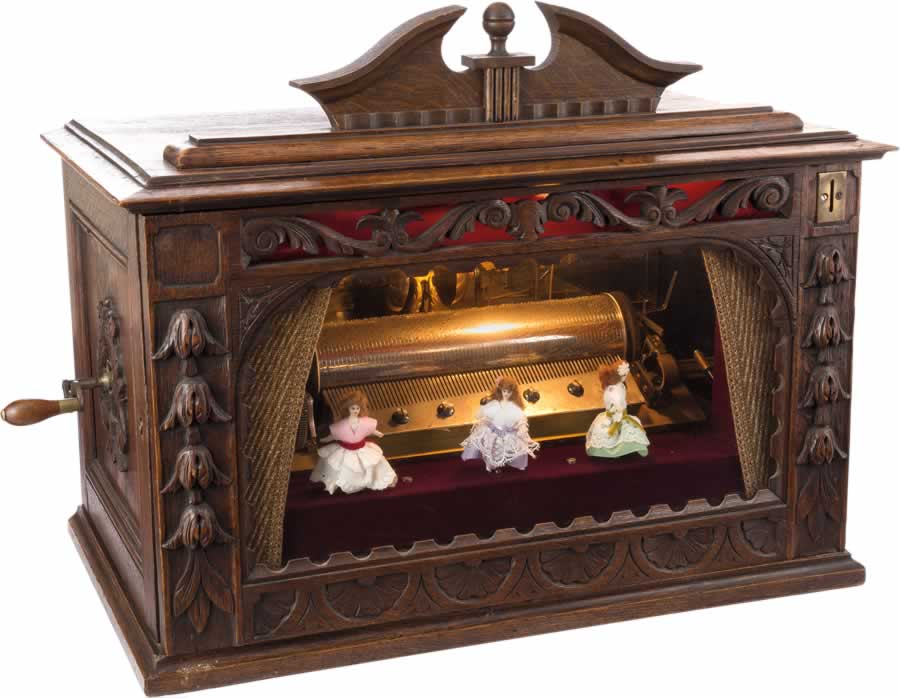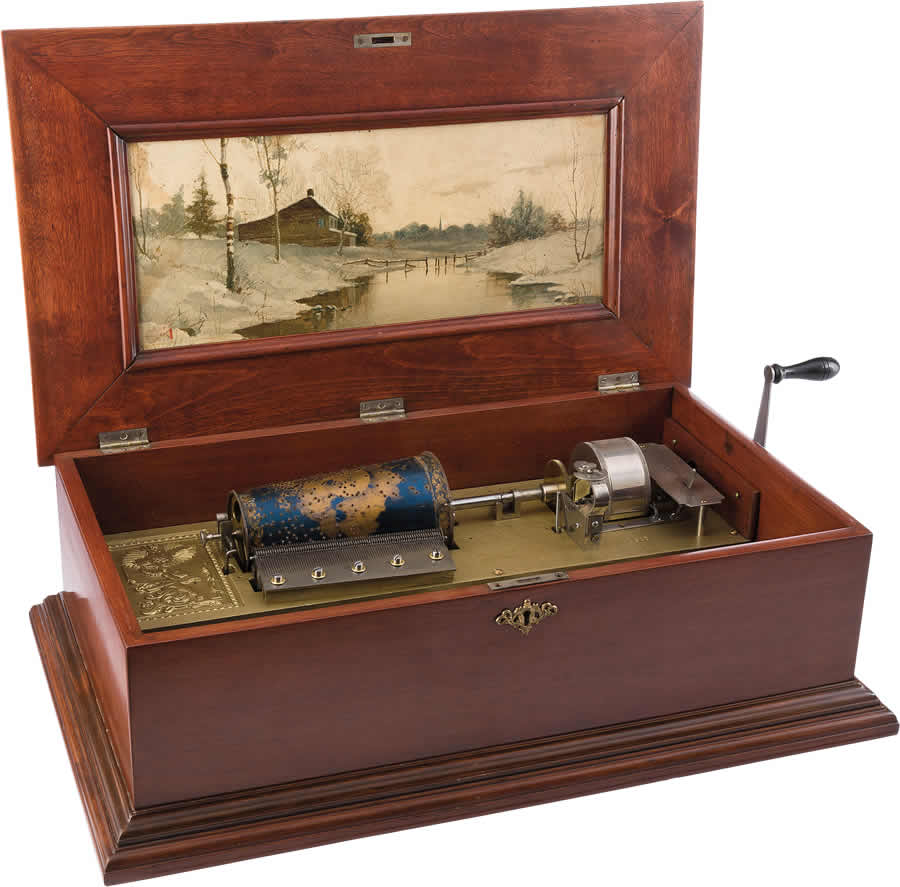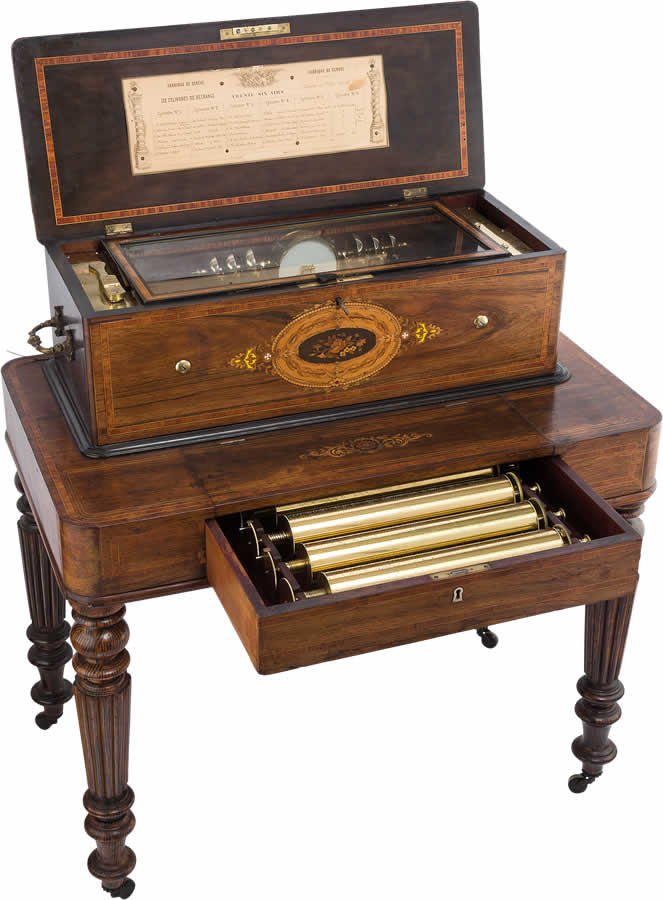RICH, DISTINCTIVE SOUNDS FILLED HOMES, DELIGHTED LISTENERS A CENTURY AGO
It was the end of the 18th century when tuned steel teeth, the vocal chords of all music boxes, were built into a musical watch. Soon thereafter, objets de vertu containing more elaborate miniature musical movements were made for royalty and the very rich.
By the 1820s, a Swiss cottage industry was producing spring-wound musical movements playing multiple songs on precision-pinned brass cylinders. These were installed in snuff boxes and clock bases, as well as plain fruitwood boxes.
EVENT
AMERICANA & POLITICAL GRAND FORMAT AUCTION 6172
May 13, 2017
Live: Dallas
Online: HA.com/6172a
INQUIRIES
Tom Slater
214.409.1441
TomS@HA.com
To request a catalog, call 866.835.3243 or visit HA.com/Catalogs
In 1864, an important innovation, later called “Sublime Harmony,” permitted multiple teeth of the same pitch to be played together for greater volume without causing distortion. Orchestra boxes were made with bells and other percussive instruments to complement the musical teeth. Some instruments were made with interchangeable cylinders. The many hours of skilled labor required for each pinned cylinder limited most to a repertoire of three or four cylinders.
In 1885, a patent for the disc music box was awarded to Paul Lochmann of Germany. The idea was a high-precision mechanism playing the musical teeth from a comparatively inexpensive music disc. It would take several years before Lochmann’s company, Symphonion, produced instruments playing metal discs with punched projections. In addition to a much lower cost for additional music, more robust musical teeth could be played due to the greater strength of the projections over the pins of the cylinder box. Various musical scales and formats, such as Sublime Harmony, were used to achieve the highest-quality music. Multiples of certain notes permitted musical arrangers to incorporate trills and other embellishments.
Disc music boxes were not inexpensive. Larger models sold for $100 and more, at a time when the average monthly wage was $36. The commercial success of music boxes during this period was a testimony to their musicality. Program material included all genres of music: popular music of the day, operatic, marches, national anthems, hymns and folk songs.
In addition to bringing music into homes, coin-operated versions provided entertainment in restaurants, hotels, taverns, ice cream parlors, confectioneries and even railroad stations. A proprietor in the United States might have a small instrument operating for only a penny a song. While the cost of the instrument may not have been covered by the pennies, it would be subsidized by the extra trade the music attracted. Upright models typically required a nickel per song, about the cost of a loaf of bread. Similarly, instruments were made to accept English pennies or German 5 or 10 pfennig coins. Some mechanisms offered a setting to give a better value by playing the song twice.
By 1900, disc music boxes had taken over the music box market. As phonograph fidelity improved and player pianos became available, the high cost began to take its toll on the sales of all music boxes. During that decade, Paul Lochmann, holder of the 1885 disc music box patent, successfully marketed disc-operated pianos and orchestrions.
“No band or orchestra instruments can produce the rich distinctive sound of these music boxes,” says Tom Slater, director of Americana auctions at Heritage. “When playing a restored music box today, we are having the same experience as its original owner over 100 years ago. It was those experiences that led to the collection of these musical treasure chests, which are now being passed on to future custodians.”
A collection of 25 music boxes is being offered at Heritage’s Americana & Political Grand Format Auction scheduled for May 13. Most boxes are expected to sell in the $5,000 to $15,000 range.
“When these were being made, we were still fighting cowboys and Indians over here,” says Walter Szymczak, a Dallas-area retired businessman who started collecting the boxes in 1995. “I’ve always been involved in antiques and I’ve always been intrigued by the intricacy, the way they were made.”
The ideal home for these treasures, Szymczak says, is the home of “anybody who appreciates history. That’s what these are all about. They’re from an era we’ll never see again, and they are beautiful pieces of furniture.”
Enlarge

From a Private Texas Music Box Collection





